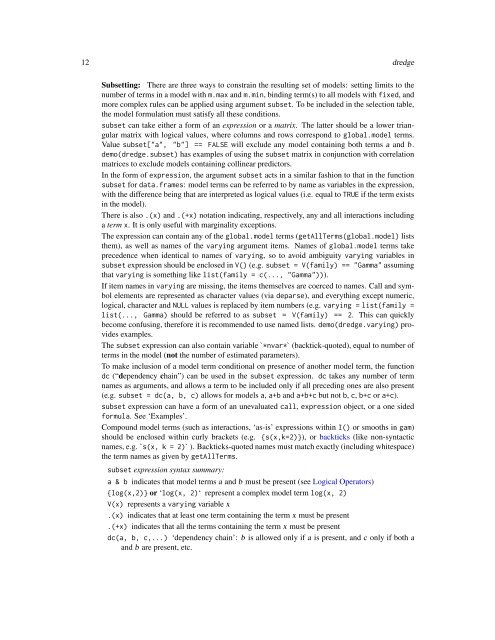Package ‘MuMIn’
Package 'MuMIn'
Package 'MuMIn'
Create successful ePaper yourself
Turn your PDF publications into a flip-book with our unique Google optimized e-Paper software.
12 dredge<br />
Subsetting: There are three ways to constrain the resulting set of models: setting limits to the<br />
number of terms in a model with m.max and m.min, binding term(s) to all models with fixed, and<br />
more complex rules can be applied using argument subset. To be included in the selection table,<br />
the model formulation must satisfy all these conditions.<br />
subset can take either a form of an expression or a matrix. The latter should be a lower triangular<br />
matrix with logical values, where columns and rows correspond to global.model terms.<br />
Value subset["a", "b"] == FALSE will exclude any model containing both terms a and b.<br />
demo(dredge.subset) has examples of using the subset matrix in conjunction with correlation<br />
matrices to exclude models containing collinear predictors.<br />
In the form of expression, the argument subset acts in a similar fashion to that in the function<br />
subset for data.frames: model terms can be referred to by name as variables in the expression,<br />
with the difference being that are interpreted as logical values (i.e. equal to TRUE if the term exists<br />
in the model).<br />
There is also .(x) and .(+x) notation indicating, respectively, any and all interactions including<br />
a term x. It is only useful with marginality exceptions.<br />
The expression can contain any of the global.model terms (getAllTerms(global.model) lists<br />
them), as well as names of the varying argument items. Names of global.model terms take<br />
precedence when identical to names of varying, so to avoid ambiguity varying variables in<br />
subset expression should be enclosed in V() (e.g. subset = V(family) == "Gamma" assuming<br />
that varying is something like list(family = c(..., "Gamma"))).<br />
If item names in varying are missing, the items themselves are coerced to names. Call and symbol<br />
elements are represented as character values (via deparse), and everything except numeric,<br />
logical, character and NULL values is replaced by item numbers (e.g. varying = list(family =<br />
list(..., Gamma) should be referred to as subset = V(family) == 2. This can quickly<br />
become confusing, therefore it is recommended to use named lists. demo(dredge.varying) provides<br />
examples.<br />
The subset expression can also contain variable `*nvar*` (backtick-quoted), equal to number of<br />
terms in the model (not the number of estimated parameters).<br />
To make inclusion of a model term conditional on presence of another model term, the function<br />
dc (“dependency chain”) can be used in the subset expression. dc takes any number of term<br />
names as arguments, and allows a term to be included only if all preceding ones are also present<br />
(e.g. subset = dc(a, b, c) allows for models a, a+b and a+b+c but not b, c, b+c or a+c).<br />
subset expression can have a form of an unevaluated call, expression object, or a one sided<br />
formula. See ‘Examples’.<br />
Compound model terms (such as interactions, ‘as-is’ expressions within I() or smooths in gam)<br />
should be enclosed within curly brackets (e.g. {s(x,k=2)}), or backticks (like non-syntactic<br />
names, e.g. `s(x, k = 2)` ). Backticks-quoted names must match exactly (including whitespace)<br />
the term names as given by getAllTerms.<br />
subset expression syntax summary:<br />
a & b indicates that model terms a and b must be present (see Logical Operators)<br />
{log(x,2)} or ‘log(x, 2)‘ represent a complex model term log(x, 2)<br />
V(x) represents a varying variable x<br />
.(x) indicates that at least one term containing the term x must be present<br />
.(+x) indicates that all the terms containing the term x must be present<br />
dc(a, b, c,...) ‘dependency chain’: b is allowed only if a is present, and c only if both a<br />
and b are present, etc.


